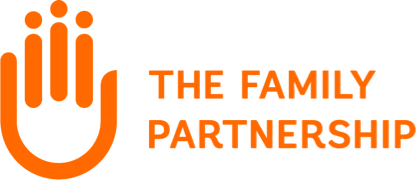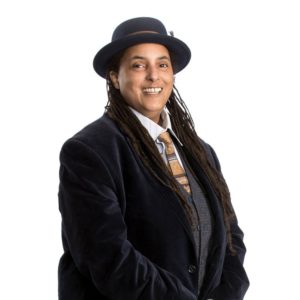
In the U.S. and around the world, the LGBTQ+ community celebrates Pride Month in June. We asked LGBTQ+ Trans BIPOC advocate Roxanne Anderson to share their story and talk about Pride.
Pride honors the 1969 uprising when patrons and supporters of the Stonewall Inn in New York City resisted police harassment and persecution, marking the beginning of a more public movement to end discriminatory laws and practices against LGBTQ+ Americans.
What is the legacy and impact of Pride Month for social change?
Millions of people celebrate Pride globally. Here in Minnesota about 450,000 people attend the Twin Cities Pride celebration (in its 50th year!) There is also MN POC Pride and there are pride celebrations in Duluth, Golden Valley, Pine City, Rochester, and many more cities and towns across the state. That is power!
The power and visibility of the Trans (transgender) community literally fueled this whole celebration we call Pride. Remember that the Stonewall riots were led by Trans women of color. (African-American Marsha P. Johnson and Latina-American Sylvia Rivera). I remember the impact of Rivera standing on stage in 1973 and calling out the larger queer community with “Y’all better quiet down”. She talked about the real discrimination, surveillance and violence she experienced.
You currently serve as Director of the Minnesota Transgender Health Coalition, and a mission of yours is creating SAFE SPACES for the LGBTQ+ community.
Since 1996, I have dedicated a great deal of time and energy to creating safer places for LGBTQ+, BIPOC communities. One of those places is RARE Productions and one of the events we produce is the Power to the People area at Twin Cities Pride, a space and stage by and for Queer BIPOC folx. It started from discrimination against a black Trans woman not getting her stage time. This year marks the 20th anniversary for us being in (Loring) park. Visibility is vital.
Talk about challenges facing the Trans community in Minnesota
The greatest challenges facing the Trans community—all communities really—are transphobia, racism and white supremacy and all the ways it impacts economics, education, housing, and employment. White supremacy leeches into and supports transphobia, ableism, and misogyny.
“When I speak about racism and white supremacy being the greatest challenges facing the Trans community, I do so with the profound understanding that white folx can love people of color and have no real understanding of what white supremacy in all its forms is or does.”
Roxanne Anderson
Can you share your back-story growing up?
I am a black presenting, mixed race, trans-racially adopted, gender non-conforming person, raised in a white home. A very WASPie white home. I grew up in a traditional family. Both my parents were preachers’ kids and worked. Our active lives with family and friends included piano, dance, girl scouts, tending our massive gardens, as well as church activities like choir, bells and youth group.
In my younger years, we lived in a city that had some diversity, in that people of color went to my school, attended our church and our family had relationships with people of color not only from our immediate environment but also in extended family/community relationships. When I was in high school, we moved to an all-white rural community. With this life history, I have the unique experience living and being with white people who really do love me, and sometimes have no understanding of the impacts racism has had on my life.
So when I speak about racism and white supremacy being the greatest challenges facing the trans community, I do so with the profound understanding that white folx can love people of color and have no real understanding of what white supremacy in all its forms is or does.
How important are Trans-specific mental health services and what are barriers to care?
Mental health care is vitally important to help counter the isolation and address the trauma of transphobia and violence. These services should support transgender folx not only during transition, but to help them transform to their most authentic, higher selves.
There are many barriers to Trans folx receiving or even seeking the support – from finances, time, a lack of insurance or stigma and not feeling worthy of care. There is a lack of culturally competent providers that have a real connection to Trans lives. Sometimes people are just so overwhelmed by pure survival they can’t even think about mental health support.
What drives you to do this advocacy work for the LGBTQ+ community?
I do this work of gay for pay or professional queer because it is my path and purpose – my legacy if you will – to make true and authentic connections, build relationships and create safer space for trans and queer BIPOC folx.
We matter, black Trans lives matter, and we have always led across social justice movements.
Roxanne Anderson is an activist, artist, entrepreneur and organizer working at the intersections of Race, Gender and Sexuality to dismantle systems of oppression.
FAQ on The Family Partnership Transgender Mental Health Services
The Family Partnership welcomes back Dianne Haulcy as the agency’s next President and CEO beginning July 11. She will succeed Molly Greenman, who is retiring June 30 after 35 years, including 18 as President and CEO.
A Minnesota native, Haulcy has 25 years of non-profit executive experience, most recently as Senior Vice President of Family Engagement at Think Small. At The Family Partnership, she will oversee a $10 million organization with 100 staff dedicated to removing barriers for families impacted by low-income, systemic racism and adversity to clear the path to greater well-being.
Returning to The Family Partnership
This is a homecoming for Haulcy, who played a crucial role in ensuring The Family Partnership’s program expansion and funding stability. She served as Executive Director of Reuben Lindh Family Services from 2006 until its merger with The Family Partnership in 2011. Haulcy then agreed to assume the Chief Operating Officer position from 2011-2014 to help lead the post-merger consolidation.
“I am so excited to be returning to The Family Partnership, it feels like coming home. My passion is working to create opportunities for families and children in Minneapolis and beyond.”
Dianne Haulcy
Tommy Hillman, Board Chair of The Family Partnership, previously served on Reuben Lindh’s board of directors. “Dianne is a well-known advocate and leader with the experience and community connections to foster deep partnerships with critical stakeholders of our organization,” said Hillman. “I have personally witnessed Dianne’s passion and deep commitment to serving our community, so I have the utmost confidence that she is the right leader to move us forward.”
Advocate for Early Childhood Education and Community Leader
Over her career, Haulcy has directed five early childhood programs all serving inner city, low-income, diverse populations. At Think Small, she directed $44 million in early childhood learning scholarship dollars from the state of Minnesota, Hennepin County and the Northside Achievement Zone (NAZ) to low-income families to access high quality early learning.
As Chair of the Voices and Choices for Children Coalition, Haulcy was instrumental in passing a 2019 law that created the Community Solutions for Healthy Child Development grant program at the Minnesota Department of Health. These grants fund programs throughout Minnesota so communities of color can improve child development outcomes. The Voices and Choices for Children Coalition steering committee is comprised of professionals of color and American Indian’s advocating on behalf of children and families of color in Minnesota.
The Minnesota Public Radio (MPR) Little Moments Count Early Risers podcast Haulcy created and hosts discusses how to talk to young children about race and racism. In two seasons the 14 episode series has attracted 40,000 downloads. Following the killing of George Floyd, Haulcy wrote a blog post as a wakeup call for educators – this podcast provides tools for raising a new generation with racial equity.
As a Senior Policy Aide for former Minneapolis Mayor Betsy Hodges, Haulcy established the nationally recognized Cradle to K Cabinet, focused on children prenatal to three years-old to ensure kindergarten-readiness.
At Reuben Lindh Family Services, Haulcy revamped the agency’s strategy and structure and improved services, including increasing early childhood education from half to full-days. The North Minneapolis and Four Directions preschools, in-home parenting services and developmental therapies The Family Partnership operates today are legacy Reuben Lindh programs.
Haulcy has held many volunteer leadership positions. She currently serves as Board Chair of NAZ, on the Governor’s Early Learning Council, and is a member of the Parent Aware Advisory Committee.
She holds a bachelor’s degree in sociology from Spelman College and a master’s degree in public affairs from the Humphrey Institute at the University of Minnesota. She lives with her husband Braxton, and two teen boys in Golden Valley, Minn.
Sustainable Design Reduces Environmental Impact
The Family Partnership intentionally located its new $22 million resource center at E. Lake Street and Bloomington Ave. to invest in sustainability of the neighborhood and build health and well-being for families. In turn, BWBR’s architects used green design features to reduce energy, water and natural resources use in order to sustain the environment and reduce operating costs for the organization.
Project manager NTH, Inc. and builder Mortenson Construction were key partners in ensuring green processes came to life in the completion of the resource center in June of 2021.
Renewable Energy – Solar Panels
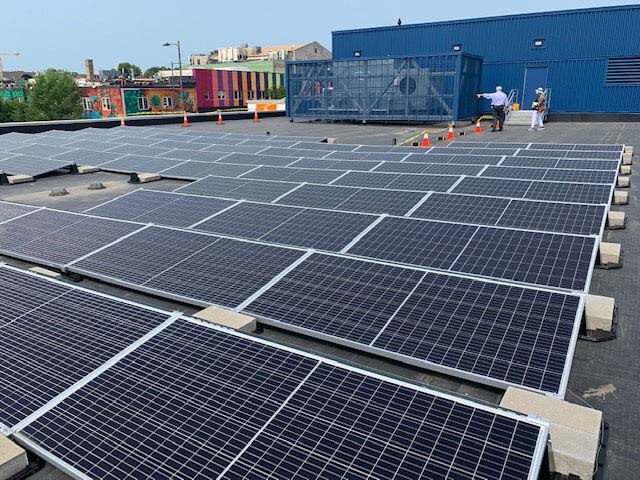
Solar panels of 50 kilowatts across two rooftops produce 60,000-kilowatt hours of energy every year. This reduces carbon dioxide by 2.5 million pounds or 57,000 trees, according to Ahmad Kian, CEO of Apadana Solar Technologies.
The solar panels will reduce The Family Partnership’s operating costs by thousands of dollars a year. The solar installation was possible by grants from the City of Minneapolis Green Cost-Share Program, Xcel Energy and donors Bruce and Julie Steiner.
Energy Efficiency
Lighting
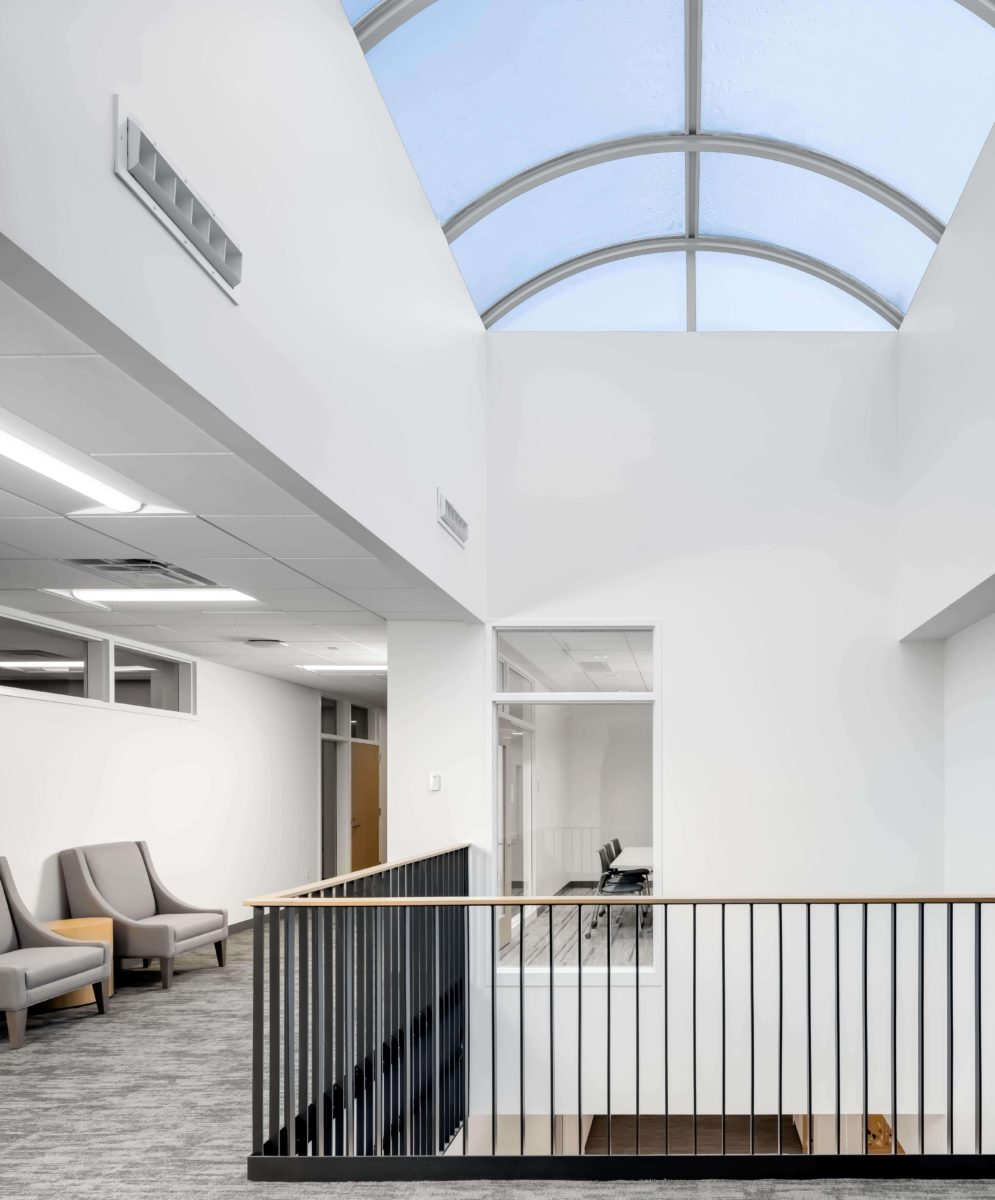
There is an abundance of natural light with a large central skylight, tall windows, and ample placement of windows throughout the building. Occupancy sensors and controlled dimmers increase the energy efficient use of LED lighting.
A portion of the electrical outlets are controlled by occupancy sensors, which eliminates “phantom” energy use, and all appliances are Energy Star compliant reducing costs of operation and saving energy.
HVAC

The gas boiler and water heater are 95% efficient. Rather than typical rooftop units, 65 heat pumps are located throughout the building creating greater efficiency, according to Sydney Wittmier, Senior Project Manager for Mortenson Construction. This heat recovery system captures and reuses heat from the heating, ventilation and air conditioning (HVAC) system exhaust, enhancing overall efficiency.
Environmental Impact
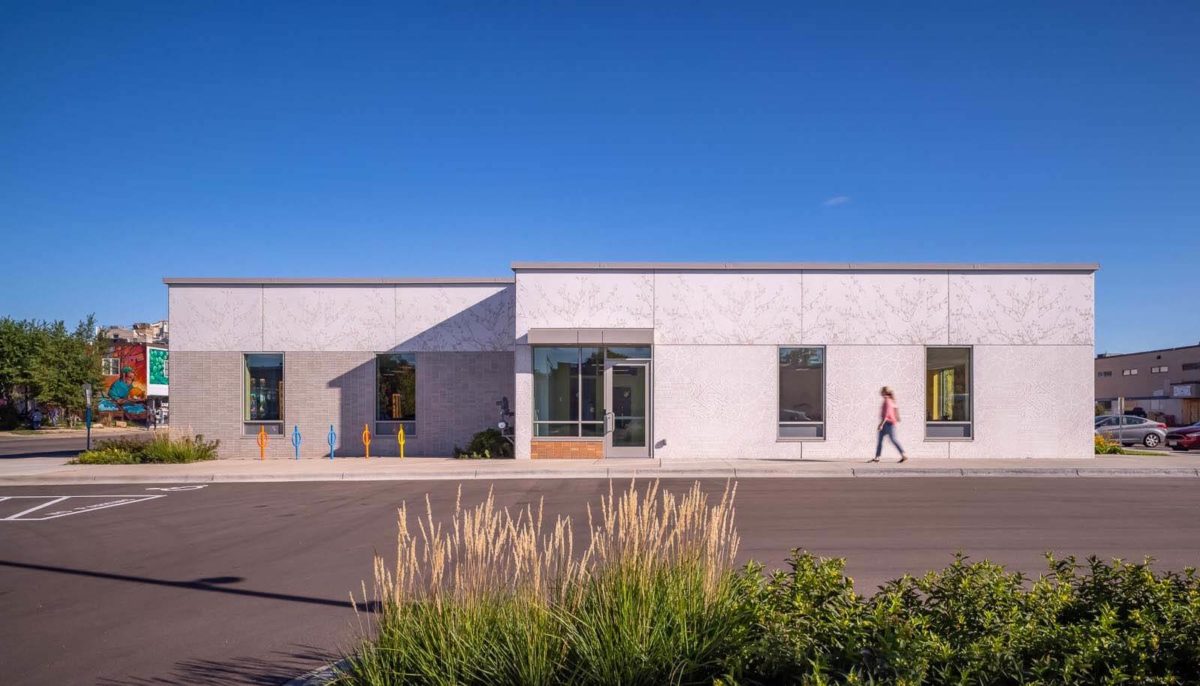
- A 190,000 gallon cistern captures and cleans rainwater and makes sure the city’s storm system isn’t overflowing (located under parking lot)
- Ample bike racks and shower facilities promote carbon free transportation
- Site is located adjacent to high frequency mass transportation
- Landscaping/plant materials require less water
- The building is considered “bird safe” – using a glass film that reduces reflectivity and avoids large expanses of glass
- Low VOC emitting construction and furniture materials were chosen
- The site is co-developed with Project for Pride in Living and will share parking and entrance drive areas reducing the manufacture of those materials
- Construction waste was sorted and recycled
For more information on the Building for Better Futures resource center, schedule a tour.
Ashley Hemnarine is joining the advancement team as Development Manager. In this role, she will be responsible for leading annual fundraising efforts and managing stewardship of donor relations.
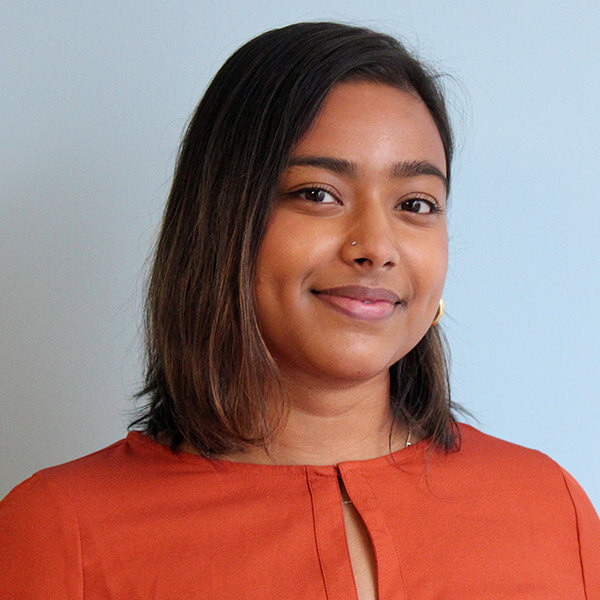
Previously, Hemnarine served as Development Associate for Touch Foundation, a nonprofit dedicated to strengthening health systems in sub-Saharan Africa. She developed and executed annual individual fundraising plans, raising over $2.3 million in the last two years. Hemnarine also served as a Senior Development Analyst for Touch Foundation and worked in fundraising for the Hackensack University Medical Center Foundation.
“Ashley brings extensive experience in the details of event and donor management and experience working directly with major gift donors,” said Kit Briem Vice President of Advancement, The Family Partnership. “When the pandemic resulted in staff turnover at her previous role, she stepped up and excelled. We are fortunate to have Ashley joining the team.”
A native of Newark, N.J., Hemnarine received her bachelor’s degree in psychology and masters of health administration from Rutgers University.
Learn more by visiting our Leadership and Ways to Give pages.
The Family Partnership’s two preschools have openings for enrollment in our early childhood programs. We asked Cassaundra Davis, Director of our North Minneapolis preschool, to share how The Family Partnership’s early education and care services are unique and what parents need to know.
Tell us about The Family Partnership’s preschools.
When our kids graduate from preschool, more than 90% test kindergarten-ready. We have two locations, one at my school in north Minneapolis, close to Theodore Wirth Parkway, and one in south Minneapolis at east Lake Street and Bloomington Avenue. We are open Monday through Friday year-round and we educate children from ages six weeks until they are eligible to enter kindergarten.
What is unique about The Family Partnership’s preschools?
We offer small class sizes and we do that intentionally to make sure that we are giving every child the attention they deserve. The Family Partnership also uses what is called a 2Gen (two-generation) approach so we not only serve the child that’s enrolled in our program – we also get to know and serve the entire family.
What developmental services do you offer?
We offer all children enrolled in our program a developmental screening within the first 30 days, so we can remove any barriers to learning. Our therapy services are all offered on-site and include occupational, physical, speech and play therapy. We also offer all children dental, vision and hearing screens throughout the year. We just want to make sure to provide children the eyeglasses, dental work or extra boost they may need to be ready for kindergarten.
“We invite your family to become part of our family. We are dedicated to every child’s success and offer resources to the entire family.”
Cassaundra Davis, Director North Minneapolis preschool
Tell us a little about yourself and your role at The Family Partnership.
I love working with kids! I have been a teacher in early childhood education for a little over 10 years and I’ve led the North Minneapolis preschool for over four years. We have a wide variety of experienced teachers who treat your children as if they are members of our own family.
How do parents enroll their children?
For north Minneapolis, they can call me, Cassandra, at (612) 294-2659.
For south Minneapolis (Four Directions), call Mary Rainey at 612-722-0766.
For more information on our Early Education and Care programs, click here.
From 10 Volunteers to more than 200, thousands of families served by The Family Partnership have received requested holiday gifts.
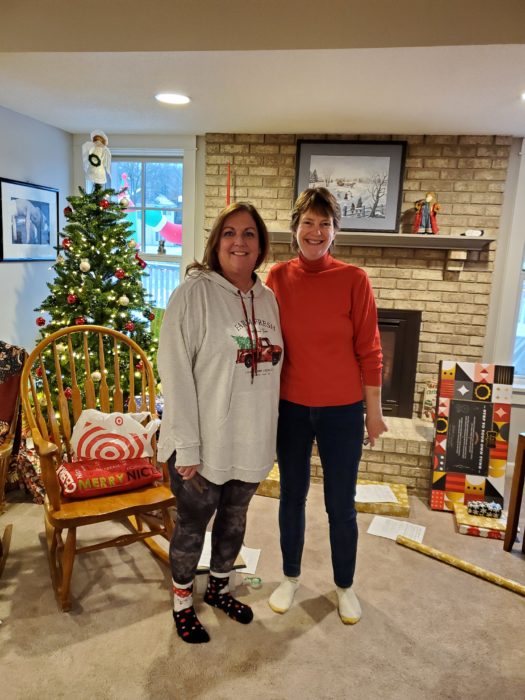
Thirty-two years ago, Aileen Hill and Sandy Nies recruited 10 people to help sponsor holiday gifts for families at The Family Partnership. Year-over-year the tradition has grown with Hill and Nies’s promotion to more than 200 volunteers.
This year, Donaldson employees are putting smiles on 230 faces with requested, wrapped gifts in time for the holidays. Over the three-plus decades, thousands of families have received gifts. From 2015-2021 alone, employees sponsored 2,081 individuals (from 521 families) with gifts valued at more than $150,000.
“I’m really social so I just invited people to join in and each year we recruited a few more co-workers,” said Nies modestly. “We have been doing it so many years it self-promotes.”
Donaldson, a global filtration solutions company, promotes the holiday gift campaign each November to its 1100 campus employees at the corporate headquarters in Bloomington, Minnesota. Nies (Manager, Finance Business Systems), Jessica Hahn (Engine Air Product Manager) and Anna Toninato (Sr. Executive Assistant) led this year’s employee drive while Hill, although retired, remains actively involved.
Supply Chain Efficiency
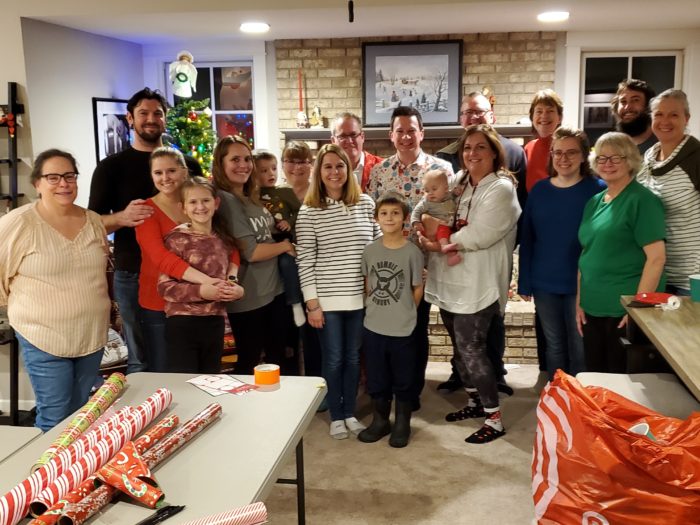
The Family Partnership provides a list of families and requested gifts to Donaldson. “We have a lot of Donaldson groups that buy and wrap gifts together to promote team building or employees that participate with their families,” said Nies.
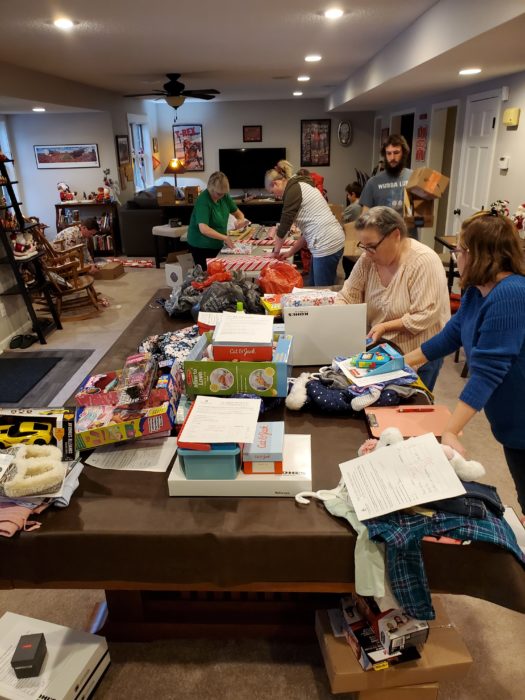
About 55 percent of the employees buy gifts directly while 45 percent donate funds. On the big Shopping Sunday, a team of 20 employees, family and friends work efficiently to buy gifts at Kohls and Target. Nies manages checkout with a sales associate, and has already ordered gifts elsewhere that she knew might not be available.
Operation Gift Wrap occurs after shopping with these same volunteers. The mountain of gifts at Hill’s house is sorted, boxed, wrapped, labeled and bagged. “Each gift is individually wrapped and identified with a number for the family and a tag for each specific person corresponding to the request list,” Nies explained.
Volunteers Make the Magic
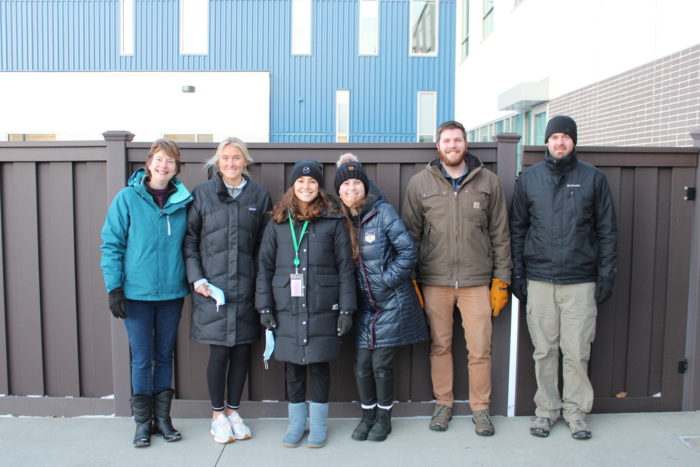
Then it is time to transport the hundreds of bagged gifts to The Family Partnership. Nies’s oldest son, who has been involved since birth, uses his vehicle and enclosed trailer for about half of the gifts. Donaldson donates their cargo van for the rest. On delivery, the gifts are sorted into designated rooms for collection by program staff for family delivery.
“We have three and four generations of families participating in bringing joy to others, and it is a highlight of our holiday season,” said Nies. The gifts are a highlight for families The Family Partnership serves too!
The Family Partnership thanks Donaldson and its employees for their incredible support at the holidays as well as during the back-to-school backpack drive. We are also grateful to the Donaldson Foundation, which provides generous support to The Family Partnership.
THANKS TO ALL OF OUR HOLIDAY HELPERS – We are thankful for the additional holiday sponsorships provided by Mortenson, Allina, Aldi’s, and countless other families. A special thanks to all who volunteered their time, including St. Thomas students and members of Alpha Gamma Delta at the University of Minnesota.
If you are inspired, learn more at our Ways to Give and Volunteer pages.
This is the ninth year Maura Howard and her family are sponsoring gifts for a family at The Family Partnership. We asked Maura to share how they connected with our work and why gift giving brings value.
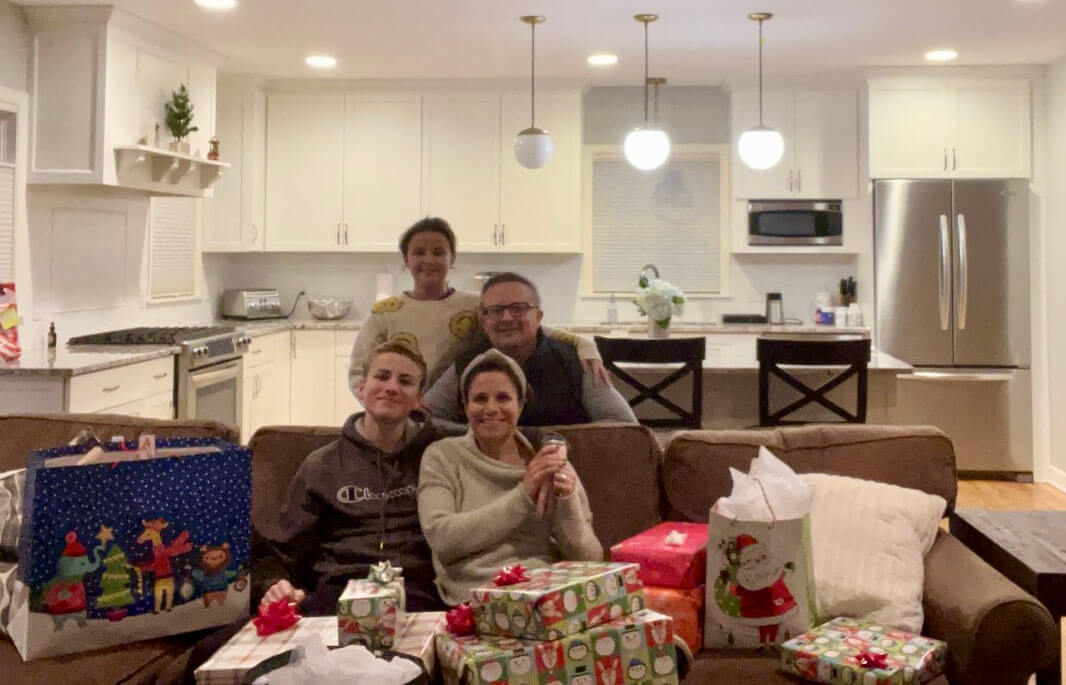
Q – What impact has gift giving to another family had on your children?
It builds empathy and awareness. My kids are now in fifth and ninth grade but when we started 9 years ago, they were like “why is Santa not helping them with gifts?” Now, my kids get more pleasure out of helping other kids. One gift request from a child is for a blanket, not toys with batteries that will end up in a landfill, but imagine a kid needing a blanket to be warm in the winter.
We want our kids to know – part of our family value system is helping others.
Maura Howard
Q – How did you become involved with The Family Partnership?
My son worked with a therapist at The Family Partnership when he was younger and we had a great experience. I also served on the Board. I love the work the organization does in mental health and in the preschools for kids to graduate kindergarten-ready.
Q – Your son experienced anxiety that one of our therapists helped with. Can you talk about that?
When my son was in the second grade the school contacted us. He was having issues with anxiety and had chewed all the erasers off the pencils in the classroom. I am not a mom that says I can do it all. I know when to outsource to people smarter than me.
I will never forget his amazing counselor at The Family Partnership – Barbara. She helped him in the second and fourth grades and we did some family therapy as well to support him as a team.
It was life changing for him.
I felt weird about taking up resources for my child, as an upper middle class white family. But, The Family Partnership assured me at the time it would not take away resources from other families.
Q – How has the therapy training continued to make a difference for your son?
The coping skills he learned have helped him navigate COVID and starting a new high school. He is the classic oldest child putting pressure on himself. Recently he used the breathing techniques he learned in therapy to calm himself down when there was a misunderstanding about a deadline for a school assignment.
I believe that if you can learn to downhill ski as a kid, you can use that muscle memory the rest of your life.
Maura Howard is Senior Business Development Director at Salo, a talent staffing and recruiting firm.
Interested in supporting The Family Partnership – visit our Ways to Give and Volunteer pages.
Photo by Monika Stawowy on Unsplash
Over 35 years Greenman has led transformative changes at The Family Partnership. She will continue to lead the organization until June 30, 2022.
The Family Partnership announced today the retirement of President and CEO Molly Greenman in 2022 after 35 years at the organization. Greenman will continue to lead the organization until June 30, 2022, to ensure a smooth transition with her successor.
Greenman joined The Family Partnership in 1986, and became CEO in 2004. Under her leadership, The Family Partnership has deepened its work with families and communities impacted by multigenerational inequity and trauma, and transformed its programs and services to clear the path for family success.
Transformational Leadership
Highlights of Greenman’s tenure include, in part:
- Focusing The Family Partnership’s work as an early adopter of brain science informed approaches, leading to the development of the Executive Functioning Across Generations™ curriculum. This year, the Minnesota Council on Nonprofits (MCN) recognized The Family Partnership with its Mission Award for Innovation. National pilots of the intervention are underway through a collaboration with the Harvard Center on the Developing Child Frontiers of Innovation (FOI) and other partners.
- Leading the organization through a name change in 2010, landing on The Family Partnership, which underscores “partnership” as a core value in every aspect of the organization’s work. She has a history of bringing groups of people together to advocate for policy and systems change.
- Leading 70+ statewide partners to successfully enact Minnesota’s Safe Harbor Law for Sexually Exploited Youth. This has resulted in more and better interventions for vulnerable youth in the state.
- Expanding mental health therapies with an emphasis on meeting people were they are at. The organization has helped increase the number of clinical social workers from BIPOC communities while providing services to underrepresented communities (BIPOC, new immigrants, refugees and LGBTQ+).
- Merging in 2011 with Minneapolis-based nonprofit, Reuben Lindh Family Services strategically expanding The Family Partnership’s reach to early childhood and parenting development. Included were two multicultural preschools—the North Minneapolis preschool, centered in the African-American community; and, Four Directions early learning center, anchored in the American Indian community.
- Adopting a holistic, 2Gen approach (working with parents/caregivers and their children) and expanding to serving the whole family across all program areas.
- Piloting an evidence-based economic mobility programming in 2018 and then expanding this coaching approach across all programs.
Nonprofit Leadership
Greenman co-founded the Metropolitan Alliance of Connected Communities (MACC) CommonWealth in 2007, an innovative model of shared administrative services that serves over 50 partner community-based organizations in Minnesota. It is the only administrative services provider in the Twin Cities run by and for nonprofits.
A national nonprofit sector leader, Greenman served from 2018-2021 as chair of the National Alliance for Strong Families and Communities Board of Directors, a national network of more than 400 human-serving organizations. Her term ended by helping steward the merger of The Alliance for Strong Families and Communities and Council on Accreditation (Alliance-COA), into a new organization Social Current.
Securing the Organization’s Future
Greenman’s strategic and persistent leadership resulted in a successful $23 million Building for Better Futures capital campaign and the construction of a new headquarters and resource center. Earlier this year, The Family Partnership relocated to 1527 E. Lake Street, at the intersection of Bloomington Ave.
The Family Partnership has intentionally located where families the organization serves reside in south and north Minneapolis. The new resource center is part of revitalizing the Lake Street corridor and has a flexible design that can adapt to changing community and program needs in the future.
“The organization is well positioned for the future, with strong board and staff leadership. I can’t wait to see the next chapter unfold, as The Family Partnership continues to support vulnerable children and families and advocate for systemic changes to create a better more equitable future for all Minnesotans. ”
Molly Greenman
Tommy Hillman, Chair of The Family Partnership Board of Directors said, “Molly’s visionary leadership has provided inspiration and set a standard of excellence at The Family Partnership for over 35 years. Most recently, her steady spirit and commitment has stabilized and energized the organization during the transition into our new building and navigating the COVID-19 pandemic. Thanks to Molly, The Family Partnership is on a path to continue building better futures for families in need, as it has done since 1878.”
Concert for a Cause October 25 benefits The Family Partnership
Concert for a Cause
October 25, 2021 — 7 p.m.
Edina High School Fick Auditorium
Masks required, social distancing observed
GET TICKETS HERE
Paul Grangaard’s passion for the trumpet led to a charitable partnership that benefits musicians and community mental health services. The concert on October 25th will benefit mental health services at The Family Partnership. We asked Paul about paying it forward with CircleRock Concerts for Community.
How did your love of the trumpet begin?
I remember Saturday mornings watching and hearing the wailing horn in The Jetsons cartoons. I loved the sound of it. I picked up the trumpet in the fifth grade, and now, playing the horn is as natural as breathing to me.
What is the purpose of CircleRock?
CircleRock Concerts for Community is a charitable partnership I formed as Producer/Donor with my friend Charles Lazarus as Music Director. It is especially fitting that our first event is with the Edina High School Concert Band as I attribute much of my career and life trajectory, including my friendship with Chuck, to the many benefits of my high school band experience in the mid-1970’s. The partnership’s goal is to raise funds for non-profit community mental health counseling, to program great music and to support the amazing musicians who perform it.
How did you choose the name CircleRock?
The circle in the brand stands for community coming together and the rock stands for what holds us in peace and harmony as we rally around it. I grew up on a street that had a grass circle in the middle that was the epicenter of our neighborhood and in one quadrant of the circle was a big red rock.
Why did you choose Mental Health as a cause?
My daughter had a mental health crisis her freshman year of college and it scared us something awful. Fortunately, she could get the help she needed. Today she’s a doctor of psychology, counseling law students at Georgetown University and other young people in her private practice
Mental illness is an epidemic today and many people who need help the most do not have the financial capacity to pay for it – The Family Partnership serves them.
You have had a very successful business career – what advice would you give to young people?
Take your education seriously and develop both your analytical/logical left brain and your creative/fun right brain. Invest in your personal relationships to keep them strong. Make a difference in the world. Care about people.
Paul Grangaard joins Charles Lazarus at around 1:51 in this CircleRock performance of “Honeydew”
